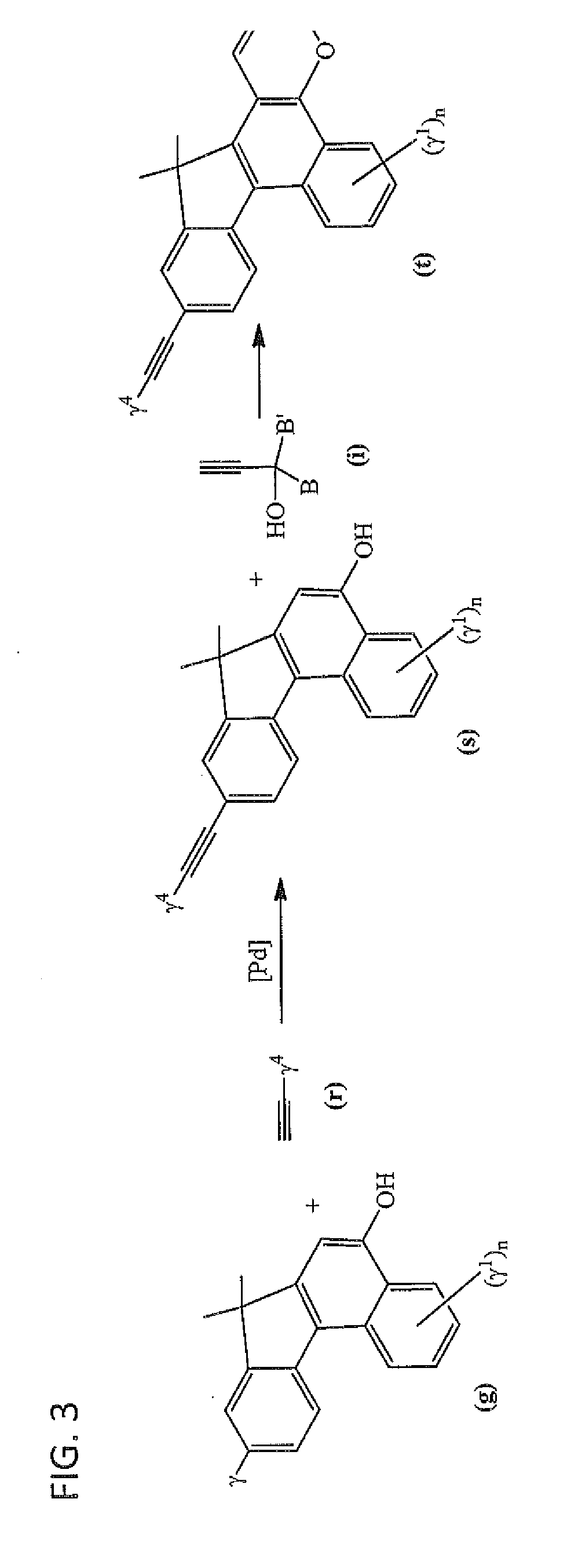Photochromic materials having extended pi-conjugated systems and compositions and articles including the same
a photochromic material and piconjugular technology, applied in the field of photochromic materials having an extended piconjugular system, can solve the problems of limited amount of photochromic material that can be incorporated into the article, limited use of conventional photochromic materials with a relatively low molar absorption coefficient in such articles, and limited amount of photochromic material
- Summary
- Abstract
- Description
- Claims
- Application Information
AI Technical Summary
Problems solved by technology
Method used
Image
Examples
example 1
Step 1
[0164]Into a 3 liter reaction (3 neck) flask was added 2,3-dimethoxy-7,7-dimethyl-9-bromo-7H-benzo[C]fluoren-5-ol (170 grams) the product of Step 5 of Example 1 in U.S. Patent Publication 2006-0228557, which disclosure is incorporated herein by reference, 4-trifluoromethyl phenyl boronic acid (100 g), Na2CO3(93 g), 1,2-dimethoxyethane (1 L), water (500 mL). Nitrogen was bubbled through the reaction mixture for 15 minutes. Tetrakis (triphenylphosphine) palladium (0) (15.2 g) was added to the reaction mixture and the resulting reaction mixture was heated to reflux and maintained at reflux overnight. The reaction mixture was cooled to room temperature and HCl (37%, 97 g) was added slowly. The reaction mixture separated and the product was extracted from the aqueous layer with ethyl acetate (EtOAc). The EtOAc layer was dried over MgSO4, and concentrated under vacuum to provide viscous oil. The oil was slurried in a mixture of EtOAc and hexane (70 / 30 volume ratio) and the resulting...
example 2
Step 1
[0166]Into a suitable reaction flask was added 2,3-dimethoxy-7,7-dimethyl-9-bromo-7H-benzo[C]fluoren-5-ol (13.3 g), 3,5-bis(trifluoromethyl)phenylboronic acid (12.0 g), K2CO3 (14.0 g), triphenylphosphine (3.4 g), 1,2-dimethoxyethane (400 mL), and water (200 mL). Nitrogen was bubbled through the reaction mixture for 10 minutes. Palladium II acetate (0.56 g) was added to the reaction mixture and the initially orange colored solution turned dark before becoming orange upon heating to reflux. After 3 hours of heating, the reaction was cooled to room temperature and the aqueous phase separated. The recovered organic phase was diluted with dichloromethane and washed twice with brine before drying over MgSO4 and evaporating the solvent. The resulting residue was chromatographed on a short silica gel column, eluting with 10% EtOAc in dichloromethane. Product containing fractions were combined and evaporated until the product began to crystallize. Hexane was added and the resulting sol...
example 3
Step 1
[0168]Into a 1 L reaction flask was added 1-(4-bromophenyl)-2-methoxycarbonyl-4-hydroxy-6,7-dimethoxynaphthalene (45 g) produced by following Steps 1-3 of Example 1, in U.S. Patent Publication 2006-0228557, which disclosure is incorporated herein by reference, except that the acetoxy group of the product of Step 3 (1-(4-bromophenyl)-2-methoxycarbonyl-4-acetoxy-6,7-dimethoxynaphthalene) was converted to hydroxy using standard methanolysis conditions (refluxing for one hour in methanol containing 10% (volume to volume) concentrated (12M) hydrochloric acid); dimethoxyethane (300 mL) and water (100 g) followed by the addition of 2-trifluoromethylphenyl boronic acid (25 g) and Na2CO3 (23 g). Nitrogen was bubbled through the resulting slurry for 15 minutes. Tetrakistriphenyl phosphine palladium (0) (4 g) was added to the reaction mixture and heated to reflux. After about 5-6 hours, the reaction was cooled to room temperature and water (50 mL) was added. The solution pH was adjusted ...
PUM
 Login to View More
Login to View More Abstract
Description
Claims
Application Information
 Login to View More
Login to View More - R&D
- Intellectual Property
- Life Sciences
- Materials
- Tech Scout
- Unparalleled Data Quality
- Higher Quality Content
- 60% Fewer Hallucinations
Browse by: Latest US Patents, China's latest patents, Technical Efficacy Thesaurus, Application Domain, Technology Topic, Popular Technical Reports.
© 2025 PatSnap. All rights reserved.Legal|Privacy policy|Modern Slavery Act Transparency Statement|Sitemap|About US| Contact US: help@patsnap.com



